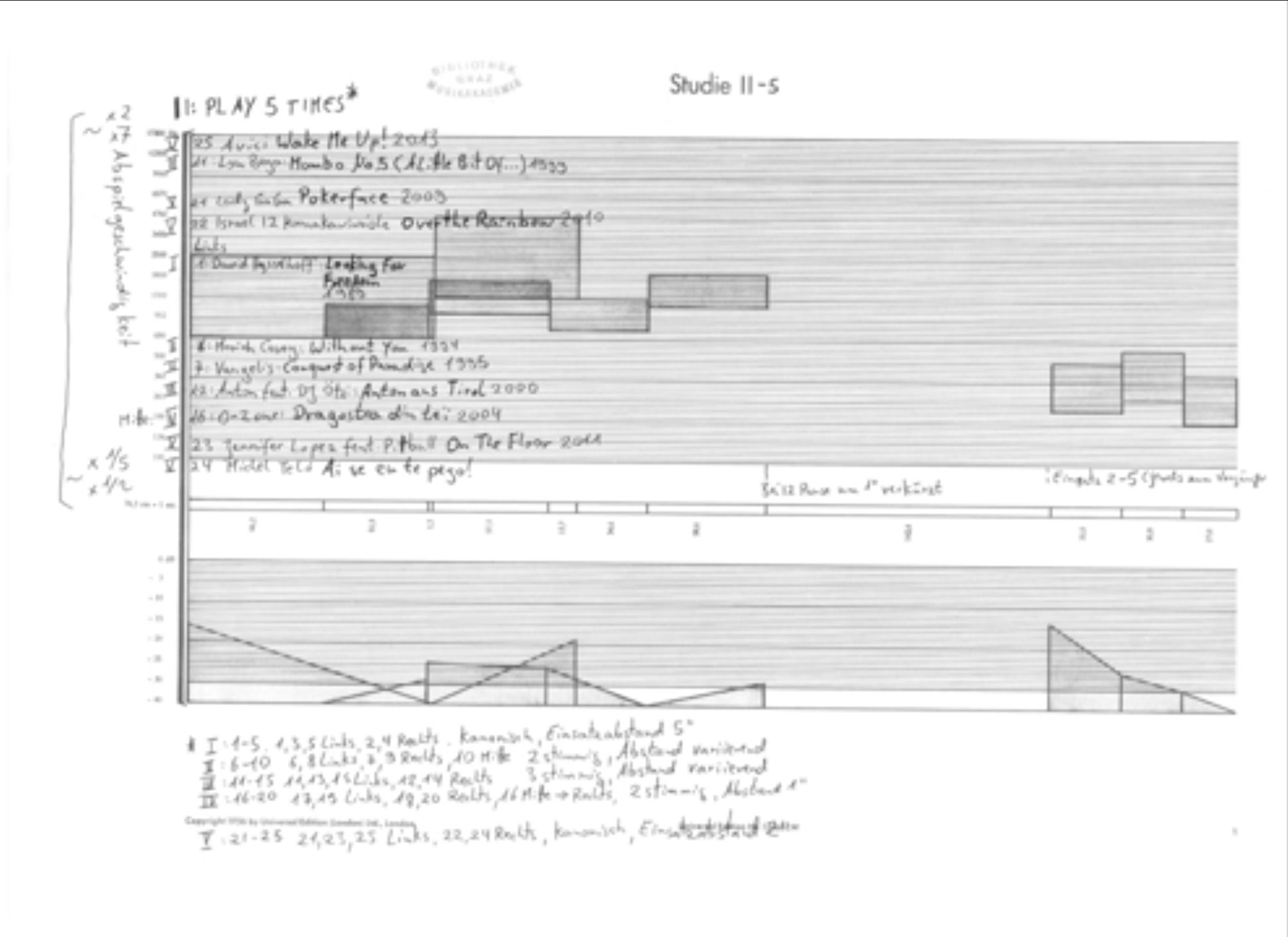Die letzten 25 Jahre in No.1 Hits der deutschen Jahrescharts dargestellt durch Karlheinz Stockhausens Studie 2 5x
Finished 2014
Paper on Wall, CD
duration:
15'32
Though still little known to non-professionals, Karlheinz Stockhausen’s Studie II is one of the 20th century’s most influential pieces of early avant-garde electronic music. In Die letzten 25 Jahre … its idea of a musical restart by inventing everything from scratch—from musical instruments, scale, horizontal and vertical proportions to the formal and structural elements—is contrasted with late 20th-century recycling and sampling culture. Studie II is organized like an instrumental composition consisting of a score that defines musical values to be played by an instrument, in this case sine-tone generators. For Die letzten 25 Jahre … the score remains basically unchanged, while the sine-tone generators have been replaced by a sampler fed with 25 German number one hits from 1989 to 2013: The score reads through 25 years of pop history.
In this way two opposing ideas of music-making collide, each read through the other: the post-war avant-garde music from Germany on the one hand, strictly avoiding tonality, beat or loop patterns and strictly distancing itself from popular music. On the other hand music as an industrial product, valued by its sales volume. While the rapid tour of musical pop history reassembles the sound of a society, of its mainstream, Studie II seems to represent a radical approach to music as a utopian project. But Stockhausen’s Studie II has become a historical piece of music as well; it can be replayed and recycled itself and become a part of sampling aesthetics even though its approach was opposed to it.
To realize Die letzten 25 Jahre ... a slightly modified MAXMSP patch by Georg Hajdu was used to trigger the samples through a real-time version of Stockhausen’s score. The numbers five and two play a central role within Stockhausen’s work itself (five-part chords, a scale consisting of steps multiplied by the , sections of five. For Die letzten 25 Jahre … they are intensified: Stockhausen’s score is played five times in a five-part canon. Every run through represents one year of number-one hits. The occasion was also the 25th anniversary of the Mousonturm Frankfurt. This piece can be performed live or played back as a five-channel stereo version.
Credits:
The realization is based on: Karlheinz Stockhausen’s: Studie II, Stockhausen Verlag 1954
It uses a modified version of the real-time MAX MSP patch by Georg Hajdu. Download: http://georghajdu.de/6-2/studie-ii/
Samples used from: David Hasselhoff: Looking for Freedom, Matthias Reim: Verdammt ich lieb’ dich, Scorpions: Wind Of Change, Dr. Alban: It’s My Life, Haddaway: What Is Love, Mariah Carey: Without You, Vangelis: Conquest Of Paradise, Los del Rio: Macarena, Sarah Brightman & Andrea Bocelli: Time To Say Goodbye, Celine Dion: My Heart Will Go On, Lou Bega: Mambo No. 5, Anton feat. DJ Ötzi: Anton aus Tirol, No Angels: Daylight In Your Eyes, Las Ketchup: The Ketchup Song (Asereje) , Deutschland sucht den Superstar: We Have A Dream, O-Zone: Dragostea din tei, Schnappi: Schnappi, das kleine Krokodil, GoLeo VI pres. Bob Sinclair feat. Gary Nesta Pine: Love Generation, DJ Ötzi & Nik P.: Ein Stern (der deinen Namen trägt) , Timbaland pres. One Republic: Apologize, Lady Gaga: Pokerface, Israel “Iz” Kamakawiwo’ole: Over The Rainbow / What A Wonderful World, Jennifer Lopez feat. Pitbull: On The Floor, Michel Telo: Ai Se Eu Te Pego, Avicii: Wake Me Up.
